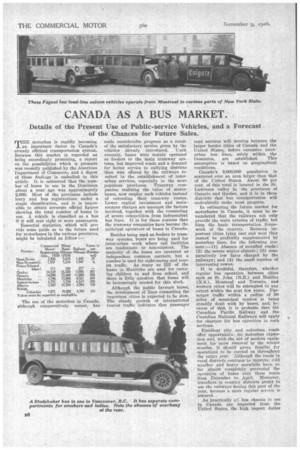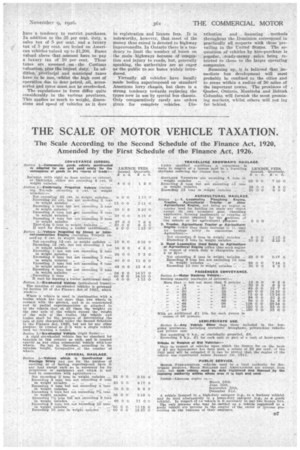CANADA AS A BUS MARKET.
Page 96

Page 97

If you've noticed an error in this article please click here to report it so we can fix it.
Details of the Present Use of Public-service Vehicles, and a Forecast , of the Chances for Future Sales.
THE .motorbus is rapidly becoming an important factor in Canada's already efficient transportation system. Because this market is regarded as being exceedingly promising, a report on the possibilities which it presents was recently published by the American Department of Commerce, and a digest of these findi,ags is embodied in this article. It is estimated that the number of buses in use in the Dominion about a year ago was approximately 2,000. Most of the provinces include lorry and bus registrations under a single classification, and it is impossible to obtain accurate official figures showing the total number of buses in use. A vehicle is classified as a bus if it will seat eight or more passengers.
Essential statistics, which will provide some guide as to the future need for motorbuses in the various provinces, might be tabulated as follow :7- Commercial Motor Buses in
Motor Road Railway use
Prc'vi99' Registration Mileage Mileage (Estima Nova Scotia 2,563 3,610 1,447 23
New Brunswick 1,357 5,224 1,947 6 Prince Edward Island. 115 300 277 — Quebec .. 14,329 16,200 5,000 307 Ontario 34,690 23,400 11,000 500 Manitoba .. 3,746 13,000 4.521 609 Saskatchewan 6,731 5,250 6,517 200 Alberta .. 2,367 15,500 4,784 150 British Columbia 9,071 19,000 4,395 165 Yukon must be regarded as negligible.
The use of the motorbus in Canada, although comparatively recent, has made considerable progress as a result of the satisfactory service given by the vehicles already introduced. Until recently, buses were mainly operated as feeders to the main tramway systems, but improved roads and a demand for better service to outlying districts than was offered by the railways resulted in the establishment of interurban services, especially in the more populous provinces. Tramway companies, realizing the value of motorbuses, now employ such vehicles instead of extending their tramway routes. Lower . capital investment and maintenance charges are amongst the factors involved, together with the countering of severe competition from independent bus lines. It is for these reasons that the tramway companies have become the prihcipal operators of buses in Canada.
Besides being used as feeders to tramway systems, buses are being used for inter-urban work where rail facilities are inadequate or non-existent. The majority of the buses are operated as independent common carriers, but a number is used for sight-seeing and tourist traffic. As many as 555 of the buses in Manitoba are used for carrying children to and from school, and there is little question that buses will be increasingly needed for this Work.
Although the public favours buses, the development of lines connecting the important cities is expected to be slow. The steady growth of international tourist traffic indicates that passenger_
road services will develop between the larger border cities of Canada and the United States, before extensive interurban bus lines, solely within the Dominion, are established. This assumption is based on geographical conditions.
Canada's 9,000,000 population is scattered over an area larger than that of the 'United States. About 60 per cent, of this 'total is located in the St. Lawrence valley in the provinces of Ontario and Quebec, and it is in these districts that bus transportation will undoubtedly make most progress.
In estimating the future market for motorbuses in Canada, it must be remembered that the railways not only provide the main arteries of traffic, but form the basic transportation framework of the Country. Between important cities lying east and west they cannot be profitably supplemented by motorbus lines, for the following reasons :—(1) Absence of metalled roads; (2) the severe winter climate ; (2) comparatively low fares charged by the railways; and (4) the small number of intervening towns.
It is doubtful, therefore, whether regular bus operation between cities such as St. John (N.B.) and Halifax (N.S.), Montreal and Toronto, and western cities will be attempted to any extent within the next few years. Passenger traffic within a radius of 50 miles of municipal centres is being steadily dealt with by buses, and, because of this, it is probable that the' Canadian Pacific Railway and the Canadian National Railways will apply for charters for bus operation in such sections. '
. Excellent city and suburban roads
offer opporturale. foy Motorbus expansion and, with the -aid of modern equip
ment for snow removal in' the winter months, it should prove feasible for operations to be carried on throughout
the entire year. -31Ithough the roads in rural districts continue to improve, cold weather and heavy snowfalls have so far almost completely prevented the operation of buses over these roads from December to April. Moreover, travellers in country districts prefer to use the railways during this part of the year, because a more regular service is assured.
As Practically all bus chassis in use in Canada are imported from the United States, the high import duties have a tendency to restrict purchases. In addition to the 35 per cent. duty, a sales tax of 5 per cent, and a luxury tax of 5 per cent. are levied on American vehicles valued up to $1,200. Buses valued above that amount have to pay a luxury tax of 10 per cent. These taxes are assessed on the Customs valuation, PriIn the import duty. In additioia, provincial and municipal taxes have to be met, •whilst the high cost of operation due to dear petrol, oil, accessories and tyres must not be overlooked.
The -regulations in force differ quite considerably in the various provinces. This applies as much to weight, dimensions and speed of vehicles as it does to registration and licence fees. It is noteworthy, _however, that most of the money thus raised is devoted to highway improvemeilts. In Ontario there is a tendency to limit the number or buses on the main highways because of congestion and .injury to roads, but, generally speaking, the authorities are as eager as the public to see buses widely introduced.
Virtually all vehicles have locally made bodies superimposed on standard American lorry chassis, but there is a strong tendency towards replacing the types now in use by special bus chassis. Only comparatively rarely are orders given for complete vehicles. Dis
tribution and financing "methods throughout the Dominion correspond in practically all respects with those 'prevailing in the United States. The acquisition of vehicles by hire-purchase is .popular, ready-money sales, being retricted to those to the larger operating companies.
Summing up, it is believed that immediate bus development will most :probably be confined to the cities and to areas within a radius -of 50 miles of the important towns. The provinces of -Quebec, Ontario, Manitoba and British Columbia will furnish the most promising markets, whilst others will not lag far behind.












































































































































































































